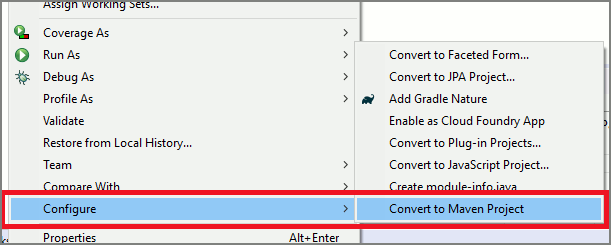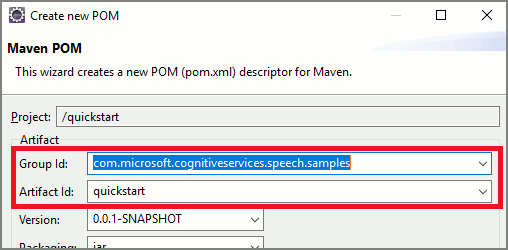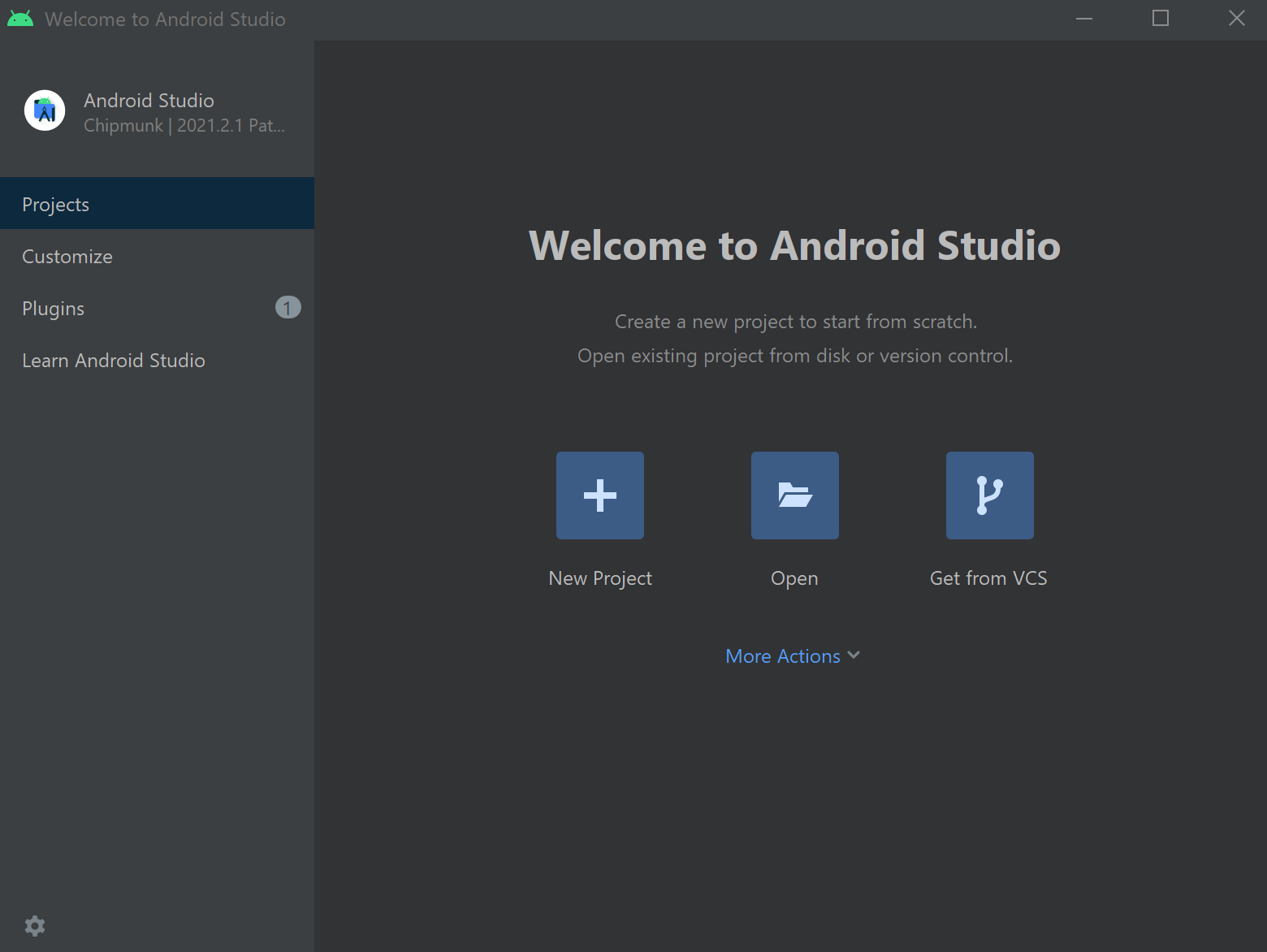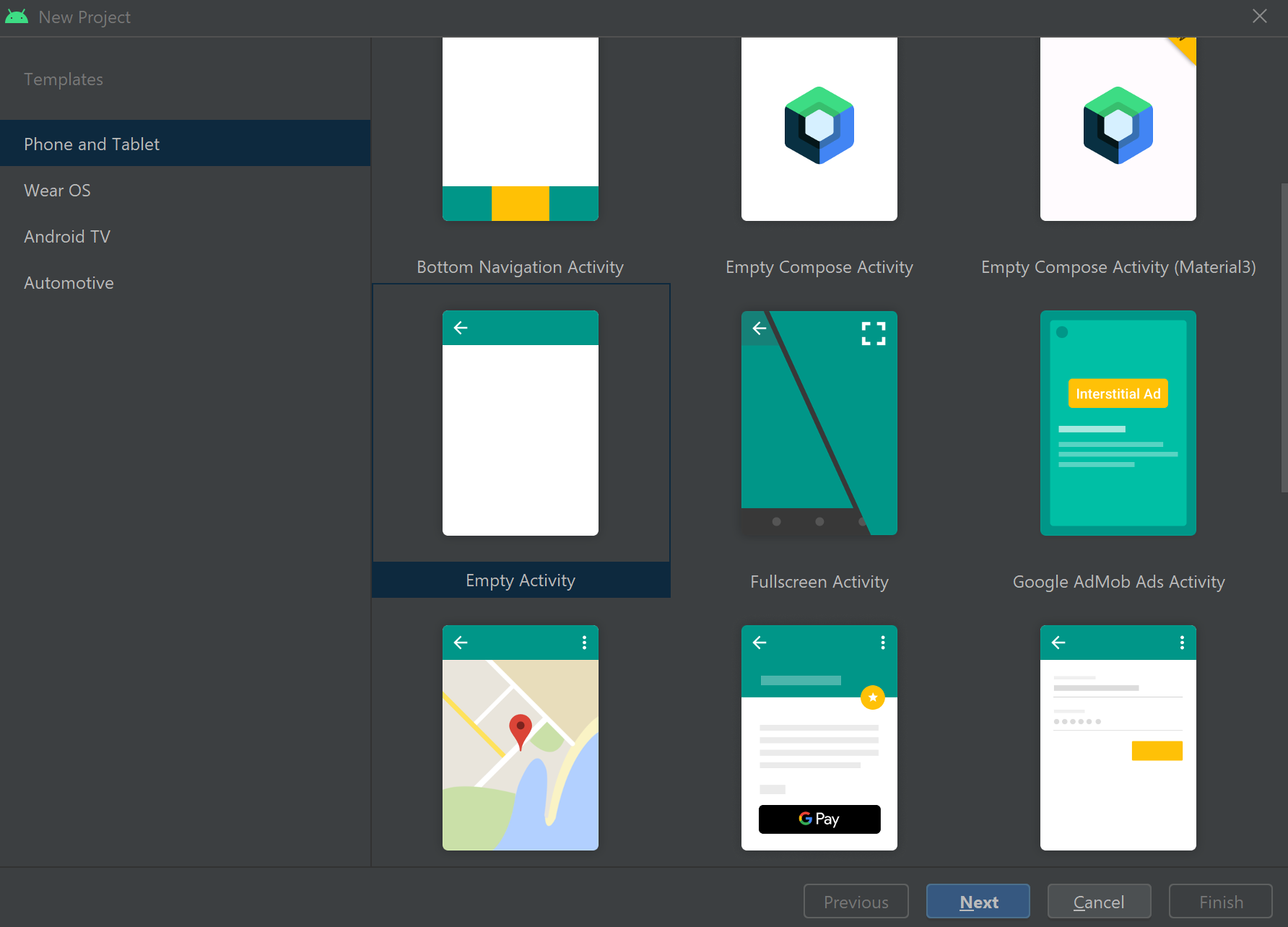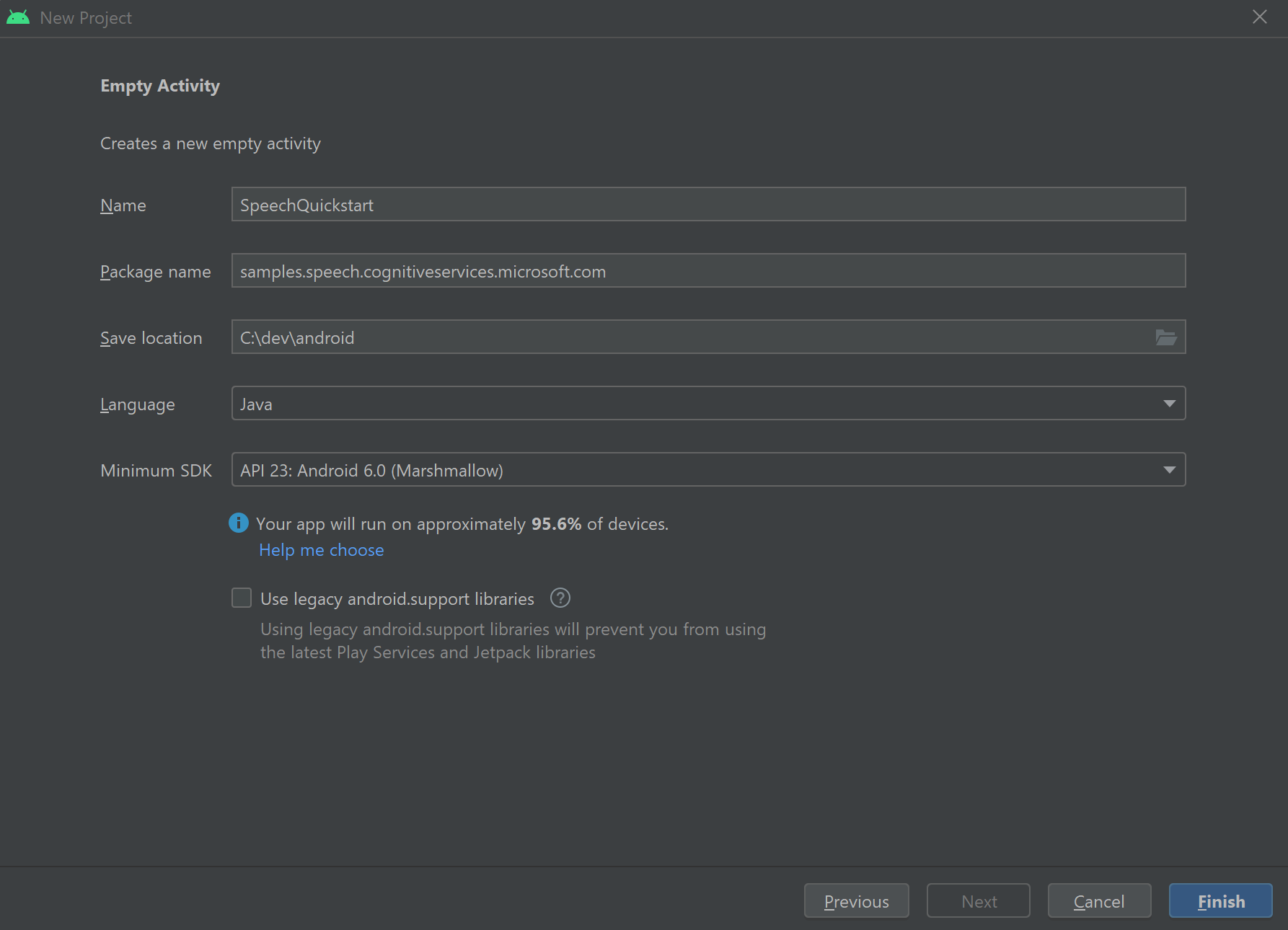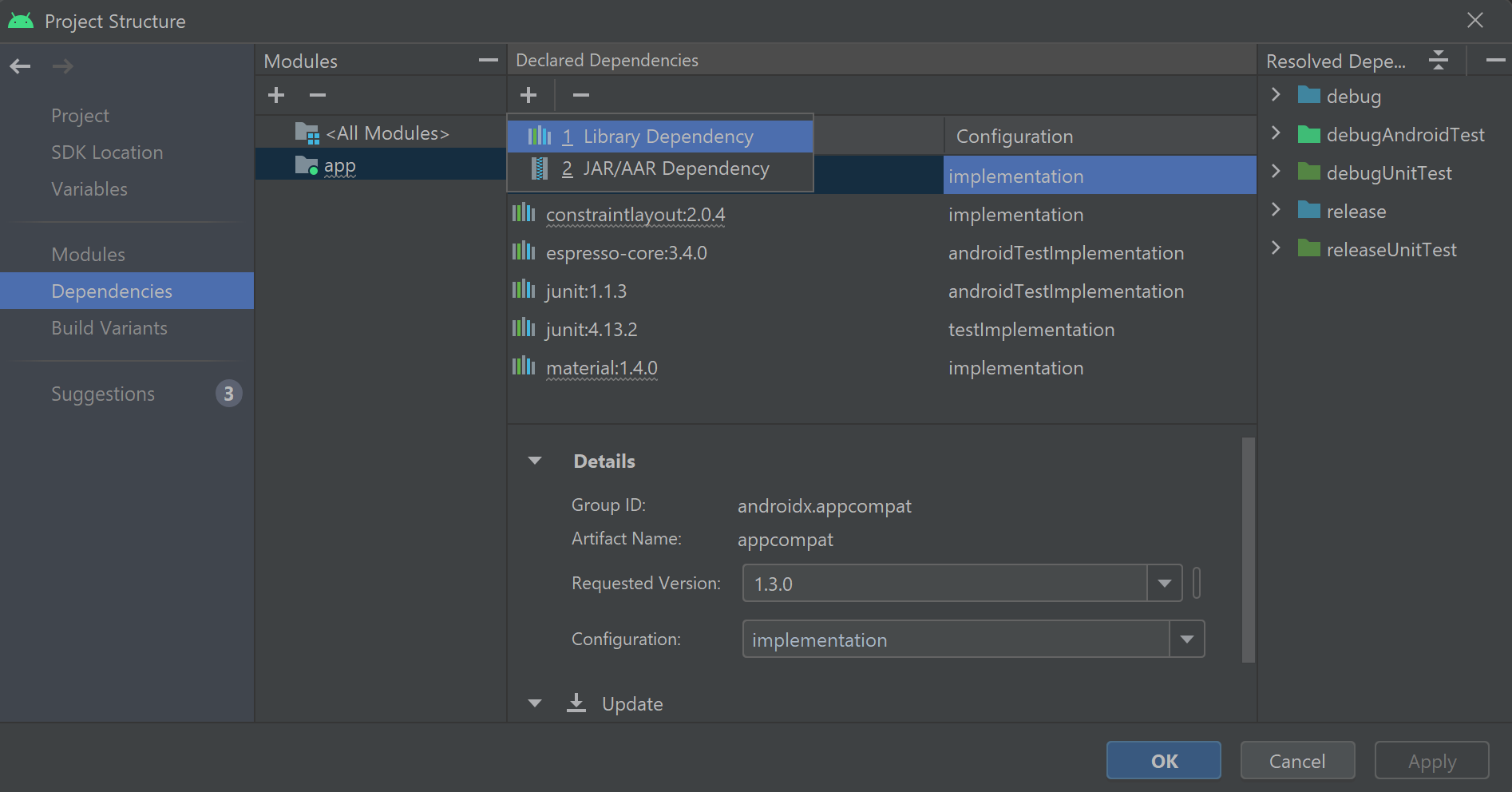如何使用自訂實體模式比對來辨識意圖
Azure AI 服務語音 SDK 有內建的功能,可使用簡單的語言模式比對來提供意圖辨識。 意圖是使用者想要執行的動作:關閉視窗、標記核取方塊、插入一些文字等等。
在本指南中,您會使用語音 SDK 來開發主控台應用程式,其會透過裝置的麥克風從使用者所說的語句推導出意圖。 您將學習如何:
- 建立 Visual Studio 專案,並讓其參考語音 SDK NuGet 套件
- 建立語音設定並取得意圖辨識器
- 透過語音 SDK API 新增意圖和模式
- 透過語音 SDK API 新增自訂實體
- 使用非同步的事件驅動連續辨識
使用模式比對的時機
使用模式比對,要是:
- 您只想要嚴格比對使用者所說的內容。 這些模式相比交談語言理解 (CLU) 而言更為嚴格。
- 您沒有 CLU 模型的存取權,但仍想得知意圖。
如需詳細資訊,請參閱模式比對概觀。
必要條件
開始使用本指南之前,請務必準備好下列項目:
- Azure AI 服務資源或統一語音資源
- Visual Studio 2019 (任何版本)。
建立專案
在 Visual Studio 2019 中建立新的 C# 主控台應用程式專案,並安裝語音 SDK。
從重複使用程式碼開始著手
讓我們開啟 Program.cs,並新增一些程式碼作為專案的基本架構。
using System;
using System.Threading.Tasks;
using Microsoft.CognitiveServices.Speech;
using Microsoft.CognitiveServices.Speech.Intent;
namespace helloworld
{
class Program
{
static void Main(string[] args)
{
IntentPatternMatchingWithMicrophoneAsync().Wait();
}
private static async Task IntentPatternMatchingWithMicrophoneAsync()
{
var config = SpeechConfig.FromSubscription("YOUR_SUBSCRIPTION_KEY", "YOUR_SUBSCRIPTION_REGION");
}
}
}
建立語音設定
您必須先建立使用 Azure AI 服務預測資源索引鍵和 Azure 區域的組態,才能夠初始化 IntentRecognizer 物件。
- 將
"YOUR_SUBSCRIPTION_KEY"取代為 Azure AI 服務預測索引鍵。 - 將
"YOUR_SUBSCRIPTION_REGION"取代為 Azure AI 服務資源區域。
此範例會使用 FromSubscription() 方法來建置 SpeechConfig。 如需可用方法的完整清單,請參閱 SpeechConfig 類別 \(英文\)。
初始化 IntentRecognizer
現在建立 IntentRecognizer。 將此程式碼插入您的語音設定的下方。
using (var recognizer = new IntentRecognizer(config))
{
}
新增一些意圖
您必須將某些模式與 PatternMatchingModel 建立關聯,並且將其套用到 IntentRecognizer。
我們首先會建立 PatternMatchingModel,並在其中新增一些意圖。
注意
我們可以將多個模式新增至 PatternMatchingIntent。
在 using 區塊內插入此程式碼:
// Creates a Pattern Matching model and adds specific intents from your model. The
// Id is used to identify this model from others in the collection.
var model = new PatternMatchingModel("YourPatternMatchingModelId");
// Creates a pattern that uses groups of optional words. "[Go | Take me]" will match either "Go", "Take me", or "".
var patternWithOptionalWords = "[Go | Take me] to [floor|level] {floorName}";
// Creates a pattern that uses an optional entity and group that could be used to tie commands together.
var patternWithOptionalEntity = "Go to parking [{parkingLevel}]";
// You can also have multiple entities of the same name in a single pattern by adding appending a unique identifier
// to distinguish between the instances. For example:
var patternWithTwoOfTheSameEntity = "Go to floor {floorName:1} [and then go to floor {floorName:2}]";
// NOTE: Both floorName:1 and floorName:2 are tied to the same list of entries. The identifier can be a string
// and is separated from the entity name by a ':'
// Creates the pattern matching intents and adds them to the model
model.Intents.Add(new PatternMatchingIntent("ChangeFloors", patternWithOptionalWords, patternWithOptionalEntity, patternWithTwoOfTheSameEntity));
model.Intents.Add(new PatternMatchingIntent("DoorControl", "{action} the doors", "{action} doors", "{action} the door", "{action} door"));
新增一些自訂實體
為了充分利用模式比對器,您可以自訂您的實體。 我們會將 "floorName" 變成可用樓層的清單。 我們也會將 "parkingLevel" 設為整數實體。
在您的意圖下插入此程式碼:
// Creates the "floorName" entity and set it to type list.
// Adds acceptable values. NOTE the default entity type is Any and so we do not need
// to declare the "action" entity.
model.Entities.Add(PatternMatchingEntity.CreateListEntity("floorName", EntityMatchMode.Strict, "ground floor", "lobby", "1st", "first", "one", "1", "2nd", "second", "two", "2"));
// Creates the "parkingLevel" entity as a pre-built integer
model.Entities.Add(PatternMatchingEntity.CreateIntegerEntity("parkingLevel"));
將模型套用至辨識器
現在必須將模型套用至 IntentRecognizer。 您可以一次使用多個模型,讓 API 接受模型集合。
在您的實體下方插入此程式碼:
var modelCollection = new LanguageUnderstandingModelCollection();
modelCollection.Add(model);
recognizer.ApplyLanguageModels(modelCollection);
辨識意圖
從 IntentRecognizer 物件,您將呼叫 RecognizeOnceAsync() 方法。 此方法會要求語音服務以單一片語辨識語音,並在識別出該片語之後停止辨識語音。
套用語言模型之後,插入此程式碼:
Console.WriteLine("Say something...");
var result = await recognizer.RecognizeOnceAsync();
顯示辨識結果 (或錯誤)
當語音服務傳回辨識結果時,我們將會列印結果。
在 var result = await recognizer.RecognizeOnceAsync(); 下方插入此程式碼:
if (result.Reason == ResultReason.RecognizedIntent)
{
Console.WriteLine($"RECOGNIZED: Text={result.Text}");
Console.WriteLine($" Intent Id={result.IntentId}.");
var entities = result.Entities;
switch (result.IntentId)
{
case "ChangeFloors":
if (entities.TryGetValue("floorName", out string floorName))
{
Console.WriteLine($" FloorName={floorName}");
}
if (entities.TryGetValue("floorName:1", out floorName))
{
Console.WriteLine($" FloorName:1={floorName}");
}
if (entities.TryGetValue("floorName:2", out floorName))
{
Console.WriteLine($" FloorName:2={floorName}");
}
if (entities.TryGetValue("parkingLevel", out string parkingLevel))
{
Console.WriteLine($" ParkingLevel={parkingLevel}");
}
break;
case "DoorControl":
if (entities.TryGetValue("action", out string action))
{
Console.WriteLine($" Action={action}");
}
break;
}
}
else if (result.Reason == ResultReason.RecognizedSpeech)
{
Console.WriteLine($"RECOGNIZED: Text={result.Text}");
Console.WriteLine($" Intent not recognized.");
}
else if (result.Reason == ResultReason.NoMatch)
{
Console.WriteLine($"NOMATCH: Speech could not be recognized.");
}
else if (result.Reason == ResultReason.Canceled)
{
var cancellation = CancellationDetails.FromResult(result);
Console.WriteLine($"CANCELED: Reason={cancellation.Reason}");
if (cancellation.Reason == CancellationReason.Error)
{
Console.WriteLine($"CANCELED: ErrorCode={cancellation.ErrorCode}");
Console.WriteLine($"CANCELED: ErrorDetails={cancellation.ErrorDetails}");
Console.WriteLine($"CANCELED: Did you set the speech resource key and region values?");
}
}
檢查您的程式碼
此時,您的程式碼應會如下所示:
using System;
using System.Threading.Tasks;
using Microsoft.CognitiveServices.Speech;
using Microsoft.CognitiveServices.Speech.Intent;
namespace helloworld
{
class Program
{
static void Main(string[] args)
{
IntentPatternMatchingWithMicrophoneAsync().Wait();
}
private static async Task IntentPatternMatchingWithMicrophoneAsync()
{
var config = SpeechConfig.FromSubscription("YOUR_SUBSCRIPTION_KEY", "YOUR_SUBSCRIPTION_REGION");
using (var recognizer = new IntentRecognizer(config))
{
// Creates a Pattern Matching model and adds specific intents from your model. The
// Id is used to identify this model from others in the collection.
var model = new PatternMatchingModel("YourPatternMatchingModelId");
// Creates a pattern that uses groups of optional words. "[Go | Take me]" will match either "Go", "Take me", or "".
var patternWithOptionalWords = "[Go | Take me] to [floor|level] {floorName}";
// Creates a pattern that uses an optional entity and group that could be used to tie commands together.
var patternWithOptionalEntity = "Go to parking [{parkingLevel}]";
// You can also have multiple entities of the same name in a single pattern by adding appending a unique identifier
// to distinguish between the instances. For example:
var patternWithTwoOfTheSameEntity = "Go to floor {floorName:1} [and then go to floor {floorName:2}]";
// NOTE: Both floorName:1 and floorName:2 are tied to the same list of entries. The identifier can be a string
// and is separated from the entity name by a ':'
// Adds some intents to look for specific patterns.
model.Intents.Add(new PatternMatchingIntent("ChangeFloors", patternWithOptionalWords, patternWithOptionalEntity, patternWithTwoOfTheSameEntity));
model.Intents.Add(new PatternMatchingIntent("DoorControl", "{action} the doors", "{action} doors", "{action} the door", "{action} door"));
// Creates the "floorName" entity and set it to type list.
// Adds acceptable values. NOTE the default entity type is Any and so we do not need
// to declare the "action" entity.
model.Entities.Add(PatternMatchingEntity.CreateListEntity("floorName", EntityMatchMode.Strict, "ground floor", "lobby", "1st", "first", "one", "1", "2nd", "second", "two", "2"));
// Creates the "parkingLevel" entity as a pre-built integer
model.Entities.Add(PatternMatchingEntity.CreateIntegerEntity("parkingLevel"));
var modelCollection = new LanguageUnderstandingModelCollection();
modelCollection.Add(model);
recognizer.ApplyLanguageModels(modelCollection);
Console.WriteLine("Say something...");
var result = await recognizer.RecognizeOnceAsync();
if (result.Reason == ResultReason.RecognizedIntent)
{
Console.WriteLine($"RECOGNIZED: Text={result.Text}");
Console.WriteLine($" Intent Id={result.IntentId}.");
var entities = result.Entities;
switch (result.IntentId)
{
case "ChangeFloors":
if (entities.TryGetValue("floorName", out string floorName))
{
Console.WriteLine($" FloorName={floorName}");
}
if (entities.TryGetValue("floorName:1", out floorName))
{
Console.WriteLine($" FloorName:1={floorName}");
}
if (entities.TryGetValue("floorName:2", out floorName))
{
Console.WriteLine($" FloorName:2={floorName}");
}
if (entities.TryGetValue("parkingLevel", out string parkingLevel))
{
Console.WriteLine($" ParkingLevel={parkingLevel}");
}
break;
case "DoorControl":
if (entities.TryGetValue("action", out string action))
{
Console.WriteLine($" Action={action}");
}
break;
}
}
else if (result.Reason == ResultReason.RecognizedSpeech)
{
Console.WriteLine($"RECOGNIZED: Text={result.Text}");
Console.WriteLine($" Intent not recognized.");
}
else if (result.Reason == ResultReason.NoMatch)
{
Console.WriteLine($"NOMATCH: Speech could not be recognized.");
}
else if (result.Reason == ResultReason.Canceled)
{
var cancellation = CancellationDetails.FromResult(result);
Console.WriteLine($"CANCELED: Reason={cancellation.Reason}");
if (cancellation.Reason == CancellationReason.Error)
{
Console.WriteLine($"CANCELED: ErrorCode={cancellation.ErrorCode}");
Console.WriteLine($"CANCELED: ErrorDetails={cancellation.ErrorDetails}");
Console.WriteLine($"CANCELED: Did you set the speech resource key and region values?");
}
}
}
}
}
}
建置並執行您的應用程式
現在您已準備好使用語音服務來建立應用程式,並測試我們的語音辨識。
- 編譯程式碼 - 從 Visual Studio 的功能表列中,選擇 [建置]>[建置解決方案]。
- 啟動應用程式 - 從功能表列中,選擇 [偵錯]>[開始偵錯],或按 F5。
- 開始辨識 - 系統會提示您說話。 預設語言為英文。 您的語音會傳送至語音服務、轉譯為文字,並在主控台中轉譯。
例如,如果您說 "Take me to floor 2",輸出應如下所示:
Say something...
RECOGNIZED: Text=Take me to floor 2.
Intent Id=ChangeFloors.
FloorName=2
另一個範例,如果您說 "Take me to floor 7",輸出應如下所示:
Say something...
RECOGNIZED: Text=Take me to floor 7.
Intent not recognized.
無法辨識任何意圖,因為 7 不在我們的 floorName 有效值清單中。
建立專案
在 Visual Studio 2019 中建立新的 C++ 主控台應用程式專案,並安裝語音 SDK。
從重複使用程式碼開始著手
讓我們開啟 helloworld.cpp,並新增一些程式碼作為專案的基本架構。
#include <iostream>
#include <speechapi_cxx.h>
using namespace Microsoft::CognitiveServices::Speech;
using namespace Microsoft::CognitiveServices::Speech::Intent;
int main()
{
std::cout << "Hello World!\n";
auto config = SpeechConfig::FromSubscription("YOUR_SUBSCRIPTION_KEY", "YOUR_SUBSCRIPTION_REGION");
}
建立語音設定
您必須先建立使用 Azure AI 服務預測資源索引鍵和 Azure 區域的組態,才能夠初始化 IntentRecognizer 物件。
- 將
"YOUR_SUBSCRIPTION_KEY"取代為 Azure AI 服務預測索引鍵。 - 將
"YOUR_SUBSCRIPTION_REGION"取代為 Azure AI 服務資源區域。
此範例會使用 FromSubscription() 方法來建置 SpeechConfig。 如需可用方法的完整清單,請參閱 SpeechConfig 類別 \(英文\)。
初始化 IntentRecognizer
現在建立 IntentRecognizer。 將此程式碼插入您的語音設定的下方。
auto intentRecognizer = IntentRecognizer::FromConfig(config);
新增一些意圖
您必須將某些模式與 PatternMatchingModel 建立關聯,並且將其套用到 IntentRecognizer。
我們首先會建立 PatternMatchingModel,並在其中新增一些意圖。 PatternMatchingIntent 是一個結構,因此我們只會使用內嵌語法。
注意
我們可以將多個模式新增至 PatternMatchingIntent。
auto model = PatternMatchingModel::FromId("myNewModel");
model->Intents.push_back({"Take me to floor {floorName}.", "Go to floor {floorName}."} , "ChangeFloors");
model->Intents.push_back({"{action} the door."}, "OpenCloseDoor");
新增一些自訂實體
為了充分利用模式比對器,您可以自訂您的實體。 我們會將 "floorName" 變成可用樓層的清單。
model->Entities.push_back({ "floorName" , Intent::EntityType::List, Intent::EntityMatchMode::Strict, {"one", "1", "two", "2", "lobby", "ground floor"} });
將模型套用至辨識器
現在必須將模型套用至 IntentRecognizer。 您可以一次使用多個模型,讓 API 接受模型集合。
std::vector<std::shared_ptr<LanguageUnderstandingModel>> collection;
collection.push_back(model);
intentRecognizer->ApplyLanguageModels(collection);
辨識意圖
從 IntentRecognizer 物件,您將呼叫 RecognizeOnceAsync() 方法。 此方法會要求語音服務以單一片語辨識語音,並在識別出該片語之後停止辨識語音。 為了簡單起見,我們將等待傳回的結果完成。
在您的意圖下插入此程式碼:
std::cout << "Say something ..." << std::endl;
auto result = intentRecognizer->RecognizeOnceAsync().get();
顯示辨識結果 (或錯誤)
當語音服務傳回辨識結果時,我們將會列印結果。
在 auto result = intentRecognizer->RecognizeOnceAsync().get(); 下方插入此程式碼:
switch (result->Reason)
{
case ResultReason::RecognizedSpeech:
std::cout << "RECOGNIZED: Text = " << result->Text.c_str() << std::endl;
std::cout << "NO INTENT RECOGNIZED!" << std::endl;
break;
case ResultReason::RecognizedIntent:
std::cout << "RECOGNIZED: Text = " << result->Text.c_str() << std::endl;
std::cout << " Intent Id = " << result->IntentId.c_str() << std::endl;
auto entities = result->GetEntities();
if (entities.find("floorName") != entities.end())
{
std::cout << " Floor name: = " << entities["floorName"].c_str() << std::endl;
}
if (entities.find("action") != entities.end())
{
std::cout << " Action: = " << entities["action"].c_str() << std::endl;
}
break;
case ResultReason::NoMatch:
{
auto noMatch = NoMatchDetails::FromResult(result);
switch (noMatch->Reason)
{
case NoMatchReason::NotRecognized:
std::cout << "NOMATCH: Speech was detected, but not recognized." << std::endl;
break;
case NoMatchReason::InitialSilenceTimeout:
std::cout << "NOMATCH: The start of the audio stream contains only silence, and the service timed out waiting for speech." << std::endl;
break;
case NoMatchReason::InitialBabbleTimeout:
std::cout << "NOMATCH: The start of the audio stream contains only noise, and the service timed out waiting for speech." << std::endl;
break;
case NoMatchReason::KeywordNotRecognized:
std::cout << "NOMATCH: Keyword not recognized" << std::endl;
break;
}
break;
}
case ResultReason::Canceled:
{
auto cancellation = CancellationDetails::FromResult(result);
if (!cancellation->ErrorDetails.empty())
{
std::cout << "CANCELED: ErrorDetails=" << cancellation->ErrorDetails.c_str() << std::endl;
std::cout << "CANCELED: Did you set the speech resource key and region values?" << std::endl;
}
}
default:
break;
}
檢查您的程式碼
此時,您的程式碼應會如下所示:
#include <iostream>
#include <speechapi_cxx.h>
using namespace Microsoft::CognitiveServices::Speech;
using namespace Microsoft::CognitiveServices::Speech::Intent;
int main()
{
auto config = SpeechConfig::FromSubscription("YOUR_SUBSCRIPTION_KEY", "YOUR_SUBSCRIPTION_REGION");
auto intentRecognizer = IntentRecognizer::FromConfig(config);
auto model = PatternMatchingModel::FromId("myNewModel");
model->Intents.push_back({"Take me to floor {floorName}.", "Go to floor {floorName}."} , "ChangeFloors");
model->Intents.push_back({"{action} the door."}, "OpenCloseDoor");
model->Entities.push_back({ "floorName" , Intent::EntityType::List, Intent::EntityMatchMode::Strict, {"one", "1", "two", "2", "lobby", "ground floor"} });
std::vector<std::shared_ptr<LanguageUnderstandingModel>> collection;
collection.push_back(model);
intentRecognizer->ApplyLanguageModels(collection);
std::cout << "Say something ..." << std::endl;
auto result = intentRecognizer->RecognizeOnceAsync().get();
switch (result->Reason)
{
case ResultReason::RecognizedSpeech:
std::cout << "RECOGNIZED: Text = " << result->Text.c_str() << std::endl;
std::cout << "NO INTENT RECOGNIZED!" << std::endl;
break;
case ResultReason::RecognizedIntent:
std::cout << "RECOGNIZED: Text = " << result->Text.c_str() << std::endl;
std::cout << " Intent Id = " << result->IntentId.c_str() << std::endl;
auto entities = result->GetEntities();
if (entities.find("floorName") != entities.end())
{
std::cout << " Floor name: = " << entities["floorName"].c_str() << std::endl;
}
if (entities.find("action") != entities.end())
{
std::cout << " Action: = " << entities["action"].c_str() << std::endl;
}
break;
case ResultReason::NoMatch:
{
auto noMatch = NoMatchDetails::FromResult(result);
switch (noMatch->Reason)
{
case NoMatchReason::NotRecognized:
std::cout << "NOMATCH: Speech was detected, but not recognized." << std::endl;
break;
case NoMatchReason::InitialSilenceTimeout:
std::cout << "NOMATCH: The start of the audio stream contains only silence, and the service timed out waiting for speech." << std::endl;
break;
case NoMatchReason::InitialBabbleTimeout:
std::cout << "NOMATCH: The start of the audio stream contains only noise, and the service timed out waiting for speech." << std::endl;
break;
case NoMatchReason::KeywordNotRecognized:
std::cout << "NOMATCH: Keyword not recognized." << std::endl;
break;
}
break;
}
case ResultReason::Canceled:
{
auto cancellation = CancellationDetails::FromResult(result);
if (!cancellation->ErrorDetails.empty())
{
std::cout << "CANCELED: ErrorDetails=" << cancellation->ErrorDetails.c_str() << std::endl;
std::cout << "CANCELED: Did you set the speech resource key and region values?" << std::endl;
}
}
default:
break;
}
}
建置並執行您的應用程式
現在您已準備好使用語音服務來建立應用程式,並測試我們的語音辨識。
- 編譯程式碼 - 從 Visual Studio 的功能表列中,選擇 [建置]>[建置解決方案]。
- 啟動應用程式 - 從功能表列中,選擇 [偵錯]>[開始偵錯],或按 F5。
- 開始辨識 - 系統會提示您說話。 預設語言為英文。 您的語音會傳送至語音服務、轉譯為文字,並在主控台中轉譯。
例如,如果您說 "Take me to floor 2",輸出應如下所示:
Say something ...
RECOGNIZED: Text = Take me to floor 2.
Intent Id = ChangeFloors
Floor name: = 2
另一個範例,如果您說 "Take me to floor 7",輸出應如下所示:
Say something ...
RECOGNIZED: Text = Take me to floor 7.
NO INTENT RECOGNIZED!
意圖識別碼是空的,因為 7 不在我們的清單中。
在本快速入門中,您會安裝適用於 Java 的 語音 SDK。
平台需求
選擇您的目標環境:
適用於 Java 的語音 SDK 與 Windows、Linux 和 macOS 相容。
在 Windows 上,您必須使用 64 位元目標結構。 需要 Windows 10 或更新版本。
為您的平台安裝 適用於 Visual Studio 2015、2017、2019 和 2022 的 Microsoft Visual C++ 可轉散發套件。 第一次安裝此套件時可能需要重新啟動。
適用於 Java 的語音 SDK 不支援 ARM64 上的 Windows。
安裝 Java 開發套件,例如 Azul Zulu OpenJDK。 Microsoft Build of OpenJDK 或您慣用的 JDK 也應該可以運作。
安裝適用於 Java 的語音 SDK
某些指示會使用特定的 SDK 版本,例如 1.24.2。 若要檢查最新版本,請搜尋我們的 GitHub 存放庫。
選擇您的目標環境:
本指南說明如何在 Java 執行階段上安裝適用於 Java 的語音 SDK。
受支援的作業系統
適用於 Java 語音 SDK 套件適用於下列作業系統:
- Windows:僅 64 位元。
- Mac:macOS X 10.14 版或更新版本。
- Linux:請參閱 支援的 Linux 發行版和目標架構。
請遵循下列步驟,使用 Apache Maven 安裝適用於 Java 的語音 SDK:
安裝 Apache Maven。
開啟您想要新專案的命令提示字元,並建立新的 pom.xml 檔案。
將下列 XML 內容複製到 pom.xml:
<project xmlns="http://maven.apache.org/POM/4.0.0" xmlns:xsi="http://www.w3.org/2001/XMLSchema-instance" xsi:schemaLocation="http://maven.apache.org/POM/4.0.0 http://maven.apache.org/xsd/maven-4.0.0.xsd"> <modelVersion>4.0.0</modelVersion> <groupId>com.microsoft.cognitiveservices.speech.samples</groupId> <artifactId>quickstart-eclipse</artifactId> <version>1.0.0-SNAPSHOT</version> <build> <sourceDirectory>src</sourceDirectory> <plugins> <plugin> <artifactId>maven-compiler-plugin</artifactId> <version>3.7.0</version> <configuration> <source>1.8</source> <target>1.8</target> </configuration> </plugin> </plugins> </build> <dependencies> <dependency> <groupId>com.microsoft.cognitiveservices.speech</groupId> <artifactId>client-sdk</artifactId> <version>1.38.0</version> </dependency> </dependencies> </project>執行下列 Maven 命令來安裝語音 SDK 和相依性。
mvn clean dependency:copy-dependencies
從重複使用程式碼開始著手
從 src dir 開啟
Main.java。以下列內容取代檔案的內容:
import java.util.ArrayList;
import java.util.Dictionary;
import java.util.concurrent.ExecutionException;
import com.microsoft.cognitiveservices.speech.*;
import com.microsoft.cognitiveservices.speech.intent.*;
public class Main {
public static void main(String[] args) throws InterruptedException, ExecutionException {
IntentPatternMatchingWithMicrophone();
}
public static void IntentPatternMatchingWithMicrophone() throws InterruptedException, ExecutionException {
SpeechConfig config = SpeechConfig.fromSubscription("YOUR_SUBSCRIPTION_KEY", "YOUR_SUBSCRIPTION_REGION");
}
}
建立語音設定
您必須先建立使用 Azure AI 服務預測資源索引鍵和 Azure 區域的組態,才能夠初始化 IntentRecognizer 物件。
- 將
"YOUR_SUBSCRIPTION_KEY"取代為 Azure AI 服務預測索引鍵。 - 將
"YOUR_SUBSCRIPTION_REGION"取代為 Azure AI 服務資源區域。
此範例會使用 fromSubscription() 方法來建置 SpeechConfig。 如需可用方法的完整清單,請參閱 SpeechConfig 類別 \(英文\)。
初始化 IntentRecognizer
現在建立 IntentRecognizer。 將此程式碼插入您的語音設定的下方。 我們會嘗試這麼做,以利用可自動封閉的介面。
try (IntentRecognizer recognizer = new IntentRecognizer(config)) {
}
新增一些意圖
您必須將某些模式與 PatternMatchingModel 建立關聯,並且將其套用到 IntentRecognizer。
我們首先會建立 PatternMatchingModel,並在其中新增一些意圖。
注意
我們可以將多個模式新增至 PatternMatchingIntent。
在 try 區塊內插入此程式碼:
// Creates a Pattern Matching model and adds specific intents from your model. The
// Id is used to identify this model from others in the collection.
PatternMatchingModel model = new PatternMatchingModel("YourPatternMatchingModelId");
// Creates a pattern that uses groups of optional words. "[Go | Take me]" will match either "Go", "Take me", or "".
String patternWithOptionalWords = "[Go | Take me] to [floor|level] {floorName}";
// Creates a pattern that uses an optional entity and group that could be used to tie commands together.
String patternWithOptionalEntity = "Go to parking [{parkingLevel}]";
// You can also have multiple entities of the same name in a single pattern by adding appending a unique identifier
// to distinguish between the instances. For example:
String patternWithTwoOfTheSameEntity = "Go to floor {floorName:1} [and then go to floor {floorName:2}]";
// NOTE: Both floorName:1 and floorName:2 are tied to the same list of entries. The identifier can be a string
// and is separated from the entity name by a ':'
// Creates the pattern matching intents and adds them to the model
model.getIntents().put(new PatternMatchingIntent("ChangeFloors", patternWithOptionalWords, patternWithOptionalEntity, patternWithTwoOfTheSameEntity));
model.getIntents().put(new PatternMatchingIntent("DoorControl", "{action} the doors", "{action} doors", "{action} the door", "{action} door"));
新增一些自訂實體
為了充分利用模式比對器,您可以自訂您的實體。 我們會將 "floorName" 變成可用樓層的清單。 我們也會將 "parkingLevel" 設為整數實體。
在您的意圖下插入此程式碼:
// Creates the "floorName" entity and set it to type list.
// Adds acceptable values. NOTE the default entity type is Any and so we do not need
// to declare the "action" entity.
model.getEntities().put(PatternMatchingEntity.CreateListEntity("floorName", PatternMatchingEntity.EntityMatchMode.Strict, "ground floor", "lobby", "1st", "first", "one", "1", "2nd", "second", "two", "2"));
// Creates the "parkingLevel" entity as a pre-built integer
model.getEntities().put(PatternMatchingEntity.CreateIntegerEntity("parkingLevel"));
將模型套用至辨識器
現在必須將模型套用至 IntentRecognizer。 您可以一次使用多個模型,讓 API 接受模型集合。
在您的實體下方插入此程式碼:
ArrayList<LanguageUnderstandingModel> modelCollection = new ArrayList<LanguageUnderstandingModel>();
modelCollection.add(model);
recognizer.applyLanguageModels(modelCollection);
辨識意圖
從 IntentRecognizer 物件,您將呼叫 RecognizeOnceAsync() 方法。 此方法會要求語音服務以單一片語辨識語音,並在識別出該片語之後停止辨識語音。
套用語言模型之後,插入此程式碼:
System.out.println("Say something...");
IntentRecognitionResult result = recognizer.recognizeOnceAsync().get();
顯示辨識結果 (或錯誤)
當語音服務傳回辨識結果時,我們將會列印結果。
在 IntentRecognitionResult result = recognizer.recognizeOnceAsync.get(); 下方插入此程式碼:
if (result.getReason() == ResultReason.RecognizedSpeech) {
System.out.println("RECOGNIZED: Text= " + result.getText());
System.out.println(String.format("%17s", "Intent not recognized."));
}
else if (result.getReason() == ResultReason.RecognizedIntent)
{
System.out.println("RECOGNIZED: Text= " + result.getText());
System.out.println(String.format("%17s %s", "Intent Id=", result.getIntentId() + "."));
Dictionary<String, String> entities = result.getEntities();
switch (result.getIntentId())
{
case "ChangeFloors":
if (entities.get("floorName") != null) {
System.out.println(String.format("%17s %s", "FloorName=", entities.get("floorName")));
}
if (entities.get("floorName:1") != null) {
System.out.println(String.format("%17s %s", "FloorName:1=", entities.get("floorName:1")));
}
if (entities.get("floorName:2") != null) {
System.out.println(String.format("%17s %s", "FloorName:2=", entities.get("floorName:2")));
}
if (entities.get("parkingLevel") != null) {
System.out.println(String.format("%17s %s", "ParkingLevel=", entities.get("parkingLevel")));
}
break;
case "DoorControl":
if (entities.get("action") != null) {
System.out.println(String.format("%17s %s", "Action=", entities.get("action")));
}
break;
}
}
else if (result.getReason() == ResultReason.NoMatch) {
System.out.println("NOMATCH: Speech could not be recognized.");
}
else if (result.getReason() == ResultReason.Canceled) {
CancellationDetails cancellation = CancellationDetails.fromResult(result);
System.out.println("CANCELED: Reason=" + cancellation.getReason());
if (cancellation.getReason() == CancellationReason.Error)
{
System.out.println("CANCELED: ErrorCode=" + cancellation.getErrorCode());
System.out.println("CANCELED: ErrorDetails=" + cancellation.getErrorDetails());
System.out.println("CANCELED: Did you update the subscription info?");
}
}
檢查您的程式碼
此時,您的程式碼應會如下所示:
package quickstart;
import java.util.ArrayList;
import java.util.concurrent.ExecutionException;
import java.util.Dictionary;
import com.microsoft.cognitiveservices.speech.*;
import com.microsoft.cognitiveservices.speech.intent.*;
public class Main {
public static void main(String[] args) throws InterruptedException, ExecutionException {
IntentPatternMatchingWithMicrophone();
}
public static void IntentPatternMatchingWithMicrophone() throws InterruptedException, ExecutionException {
SpeechConfig config = SpeechConfig.fromSubscription("YOUR_SUBSCRIPTION_KEY", "YOUR_SUBSCRIPTION_REGION");
try (IntentRecognizer recognizer = new IntentRecognizer(config)) {
// Creates a Pattern Matching model and adds specific intents from your model. The
// Id is used to identify this model from others in the collection.
PatternMatchingModel model = new PatternMatchingModel("YourPatternMatchingModelId");
// Creates a pattern that uses groups of optional words. "[Go | Take me]" will match either "Go", "Take me", or "".
String patternWithOptionalWords = "[Go | Take me] to [floor|level] {floorName}";
// Creates a pattern that uses an optional entity and group that could be used to tie commands together.
String patternWithOptionalEntity = "Go to parking [{parkingLevel}]";
// You can also have multiple entities of the same name in a single pattern by adding appending a unique identifier
// to distinguish between the instances. For example:
String patternWithTwoOfTheSameEntity = "Go to floor {floorName:1} [and then go to floor {floorName:2}]";
// NOTE: Both floorName:1 and floorName:2 are tied to the same list of entries. The identifier can be a string
// and is separated from the entity name by a ':'
// Creates the pattern matching intents and adds them to the model
model.getIntents().put(new PatternMatchingIntent("ChangeFloors", patternWithOptionalWords, patternWithOptionalEntity, patternWithTwoOfTheSameEntity));
model.getIntents().put(new PatternMatchingIntent("DoorControl", "{action} the doors", "{action} doors", "{action} the door", "{action} door"));
// Creates the "floorName" entity and set it to type list.
// Adds acceptable values. NOTE the default entity type is Any and so we do not need
// to declare the "action" entity.
model.getEntities().put(PatternMatchingEntity.CreateListEntity("floorName", PatternMatchingEntity.EntityMatchMode.Strict, "ground floor", "lobby", "1st", "first", "one", "1", "2nd", "second", "two", "2"));
// Creates the "parkingLevel" entity as a pre-built integer
model.getEntities().put(PatternMatchingEntity.CreateIntegerEntity("parkingLevel"));
ArrayList<LanguageUnderstandingModel> modelCollection = new ArrayList<LanguageUnderstandingModel>();
modelCollection.add(model);
recognizer.applyLanguageModels(modelCollection);
System.out.println("Say something...");
IntentRecognitionResult result = recognizer.recognizeOnceAsync().get();
if (result.getReason() == ResultReason.RecognizedSpeech) {
System.out.println("RECOGNIZED: Text= " + result.getText());
System.out.println(String.format("%17s", "Intent not recognized."));
}
else if (result.getReason() == ResultReason.RecognizedIntent)
{
System.out.println("RECOGNIZED: Text= " + result.getText());
System.out.println(String.format("%17s %s", "Intent Id=", result.getIntentId() + "."));
Dictionary<String, String> entities = result.getEntities();
switch (result.getIntentId())
{
case "ChangeFloors":
if (entities.get("floorName") != null) {
System.out.println(String.format("%17s %s", "FloorName=", entities.get("floorName")));
}
if (entities.get("floorName:1") != null) {
System.out.println(String.format("%17s %s", "FloorName:1=", entities.get("floorName:1")));
}
if (entities.get("floorName:2") != null) {
System.out.println(String.format("%17s %s", "FloorName:2=", entities.get("floorName:2")));
}
if (entities.get("parkingLevel") != null) {
System.out.println(String.format("%17s %s", "ParkingLevel=", entities.get("parkingLevel")));
}
break;
case "DoorControl":
if (entities.get("action") != null) {
System.out.println(String.format("%17s %s", "Action=", entities.get("action")));
}
break;
}
}
else if (result.getReason() == ResultReason.NoMatch) {
System.out.println("NOMATCH: Speech could not be recognized.");
}
else if (result.getReason() == ResultReason.Canceled) {
CancellationDetails cancellation = CancellationDetails.fromResult(result);
System.out.println("CANCELED: Reason=" + cancellation.getReason());
if (cancellation.getReason() == CancellationReason.Error)
{
System.out.println("CANCELED: ErrorCode=" + cancellation.getErrorCode());
System.out.println("CANCELED: ErrorDetails=" + cancellation.getErrorDetails());
System.out.println("CANCELED: Did you update the subscription info?");
}
}
}
}
}
建置並執行您的應用程式
現在您已準備好建置應用程式,並使用語音服務和內嵌模式比對器來測試我們的意圖辨識。
選取 Eclipse 中的 [執行] 按鈕或按 ctrl+F11,然後監看「說出某些內容...」提示的輸出。 一旦出現,請說出您的語句並觀看輸出。
例如,如果您說 "Take me to floor 2",輸出應如下所示:
Say something...
RECOGNIZED: Text=Take me to floor 2.
Intent Id=ChangeFloors.
FloorName=2
另一個範例,如果您說 "Take me to floor 7",輸出應如下所示:
Say something...
RECOGNIZED: Text=Take me to floor 7.
Intent not recognized.
無法辨識任何意圖,因為 7 不在我們的 floorName 有效值清單中。
意見反應
即將登場:在 2024 年,我們將逐步淘汰 GitHub 問題作為內容的意見反應機制,並將它取代為新的意見反應系統。 如需詳細資訊,請參閱:https://aka.ms/ContentUserFeedback。
提交並檢視相關的意見反應
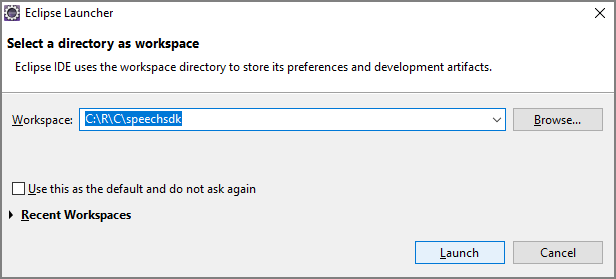
![[新增專案] 對話方塊的螢幕擷取畫面,其中反白顯示了 [Java 專案]。](media/sdk/qs-java-jre-02-select-wizard.png)
![[新增 Java 專案精靈] 的螢幕擷取畫面,其中有建立 Java 專案的選項。](media/sdk/qs-java-jre-03-create-java-project.png)
